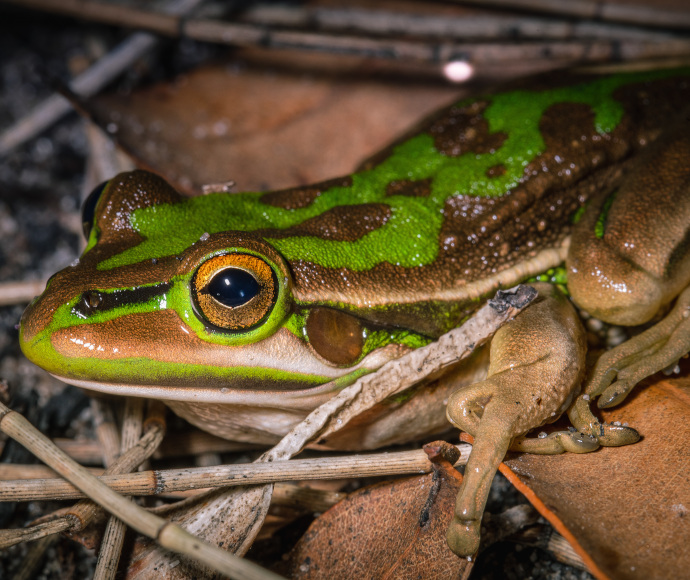Hopping to see you soon! New ponds connect frogs on Ash Island
Endangered green and golden bell frogs in the north of Ash Island will soon be able to mix more easily with their larger group of froggy friends down in the island’s south – but they need your help.
Volunteers, government and industry partners are creating a series of new ponds so the 2 parts of the Kooragang bell frog population can meet up on the island within the Hunter Wetlands National Park, 12 km west of Newcastle.
Are you free this Saturday morning at 9 am? NSW National Parks and Wildlife Service and Trees in Newcastle need volunteers to help plant out the pond sites, with families welcome and a light lunch provided.
As well as helping to connect habitat, the ponds will provide refuges in dry periods and breeding habitat to help rebuild frog numbers.
In the vein of ‘Froggie wants a wife’, the ponds came about after the University of Newcastle worked with the NSW Government’s Saving our Species program and industry partners to monitor green and golden bell frogs across the National Parks and Wildlife Service and industry-managed wetlands.
The University of Newcastle realised there was very little movement between the smaller northern bell frog subpopulation and the larger southern subpopulation, so recommended placing a series of artificial ‘cluster ponds’ across the island to help the frogs mingle.
Each new ‘cluster pond’ has one large, 1.5 m deep circular tank-pond to provide permanent fresh water as a refuge during dry periods or when wetlands become hypersaline, and a shallow 3-chamber trough to provide preferred breeding habitat.
Frogs can enter the lower ponds for a quick dip-and-meet or hop up rock-basket ramps to jump into the large tank for a deep dive with fellow amphibians.
The wired-together rock ramps also provide hidey holes in cracks and crevices, in which the frogs can heat up from the sun-warmed rocks. Heat can help frogs shed the deadly chytrid fungus which emerged worldwide 25 years ago and is one of their biggest threats – with the rocks acting similarly to the famous ‘frog saunas’ that went viral this year.
The ponds are also raised above ground-level, preventing tiny, introduced tadpole- and egg-eating fish called gambusia from washing into them after heavy rain.
Following the success of the first prototype pond that was set up in mid–2023, a further 7 cluster ponds were installed in June this year and are now being planted out. There is potential to build up to 20 more ponds over the next 4 years.
Each of the 8 cluster ponds is like a mini retreat, complete with accommodation, frog sauna and different sized pools.
The design builds on trial ponds first constructed by Port Waratah Coal Services. It supplements the artificial pond features incorporated by Hunter and Central Coast Development Corporation as part of remediating and managing the former Kooragang Island Waste Emplacement Facility.
Monitoring by the University of Newcastle and the Saving our Species program in 2023–24 found low numbers of green and golden bell frogs on Ash Island, including in the Hunter Wetlands National Park, probably due to lower than predicted rainfall during the breeding season.
The information helped the team understand that artificial sources of freshwater regularly spaced across the island could likely help frogs survive dry years, plus allow them to move more easily across the island.
National Parks and Wildlife Service is working with Trees in Newcastle, Hunter Local Land Services, Newcastle Coal Infrastructure Group, Port Waratah Coal Services, the University of Newcastle and community volunteers to continue building artificial habitat ponds at strategic locations across Ash Island.
This project is supported by funding from Newcastle Coal Infrastructure Group, Port Waratah Coal Services and the NSW Government’s Saving our Species program.
To volunteer this Saturday (for what is the third community planting day), use the link below and select 'Fill in an application' to register:
For additional Trees in Newcastle volunteering opportunities please see:
Quotes attributable to project lead – Project Officer, Conservation, National Parks and Wildlife Service Hunter Central Coast Area Erica Goldsmith
'The green and golden bell frogs of Ash Island need our help to find each other, and to start rebuilding their numbers in the north.
'The construction of new "pathways" – or frog ponds – across the island is vital to enable this endangered species of frog to meet up, and it wouldn’t be happening without our funders, partners, and local volunteers.
'This project is very "Newcastle". Its collaborative approach to conservation reflects the Novocastrian spirit of helping, mateship and respect for the local environment.'
